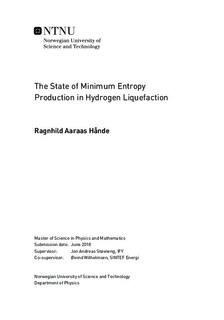| dc.description.abstract | The main object of this thesis is to understand how to improve the hydrogen liquefaction process, by studying energy efficient heat exchanger design. This study is limited to the low temperature cooling (cryogenic cooling) of hydrogen gas from about 47K to 29K. The energy efficient heat exchanger design is found by minimizing the entropy production. A plate fin heat exchanger with catalyst pellets in some of the layers is used. In this heat exchanger there are three sources of entropy production: The heat transfer through the walls of the heat exchanger, the spin-isomer conversion reaction and the pressure drop.
This thesis presents optimal cooling strategies for two hydrogen heat exchangers operating at different conditions. The optimal cooling strategy is defined as the temperature profile of the cooling medium resulting in a minimum produced entropy. The first heat exchanger is operating at about 20 bar and the second is operating at about 80 bar.
The optimal paths are compared to reference cases. In the reference cases, hydrogen gas is used as cooling medium (refrigerant). The optimal cooling strategies are obtained by using optimal control theory. In the optimization, there are no restrictions on what temperatures the cooling medium may take. All boundary conditions are fixed, except the outlet pressure.
The optimization resulted in an improvement in total entropy production of 14.90% in the 20 bar case. In the 80 bar case, the improvement is 2.15%. This finding indicates that hydrogen, the baseline reference, could be an good choice of refrigerant in this particular 80 bar case.
The optimizations also show that the heat transfer and the hydrogen spin-isomer reaction are the most important sources of entropy production, and that they are almost equally important throughout the entire heat exchanger in both cases. This is due to the slow nature of the hydrogen spin-isomer reaction, which makes the hydrogen heat exchanger different from other reactors/heat exchangers studied in literature. In literature, optimal reactors/heat exchangers have been characterized by a reaction mode and a heat transfer mode. These
modes are not present in our hydrogen liquefier. However, we have found that Eivind Johannessens hypothesis concerning equipartition of entropy production and forces in systems with too few control variables, to some degree applies to this system. In the 20 bar case there is only a 2,39% deviation between the total entropy production in the equipartition of entropy production state and the optimal state. | en |

